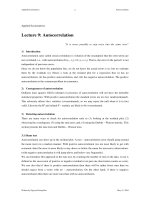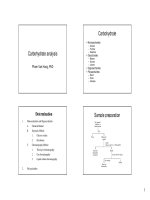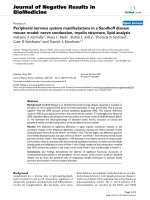lecture 9 lipid analysis
Bạn đang xem bản rút gọn của tài liệu. Xem và tải ngay bản đầy đủ của tài liệu tại đây (122.6 KB, 12 trang )
1
Lipid analysis
Pham Van Hung, PhD
Roles of Food Lipids
z Energy Source
z Carrier of Fat Soluble Vitamins
z Main Flavor Source of Foods
z Hormone and Cell Structure
z Nerve System
z Thermal Insulation of Body
z Mouth Feeling
z Texture of Foods
z Emulsifying Agents
z Mold Releasing and Anti-spattering Agent
Definition
Any of a group of substances that in
general are soluble in organic solvents,
but are not soluble in water.
1. Fatty acids
2. Neutral fats and oils
3. Waxes
4. Phospholipid
5. Sterols
6. Fat soluble vitamins lipids:
Types of Lipids
Fatty Acids
O
R C OH
#1 Carbon
Acid Group
O
R C OH
Non-polar End - Hydrophobic End
(Fat-soluble tail)
Polar End - Hydrophilic End
Saturated Fatty Acids
CH
3
CH
2
CH
2
CH
2
CH
2
CH
2
CH
2
C OH
O
1
2
4
5
6
7
83
Octanoic Acid
2
Unsaturated Fatty Acids
CH
3
CH
2
CH
2
CH
2
CH
2
CH
2
CH
2
C OH
O
1
2
4
5
6
7
83
CH
3
CH
2
CH
2
CH
2
CH
2
CH
2
CH
2
C OH
O
1
2
4
5
6
7
83
3 - Octenoic Acid
3, 6 - Octadienoic Acid
Short hand: 8:1 (Δ3)
8:2 (Δ3,6)
Cis 9 - Octadecenoic Acid (oleic)
Trans 9 - Octadecenoic Acid (elaidic acid)
O
CH
3
(CH
2
)
7
C C (CH
2
)
7
C OH
H
H
910
O
CH
3
(CH
2
)
7
C C (CH
2
)
7
C OH
H
H
Cis and Trans Fatty Acids
Fatty Acids
Polyunsaturated Fatty Acids
Linoleic acid: Cis, cis, 9, 12 - Octadecadienoic acid
Linolenic acid: Cis, cis, cis 9, 12, 15 - Octadecatrienoic acid
Arachidonic acid: Cis, cis, cis, cis 5, 8, 11, 14 - Eicosatetraenoic acid
Linoleic Acid
Linolenic Acid
Arachidonic Acid
Naturally-occurring Fatty Acids
R CH
2
[ CH CH CH
2
CH CH ] CH
2
C OH
O
765
43
1. Cis form
2. Not conjugated isolated double bond.
3. Even numbered fatty acids.
n
Saturated Fatty Acids
Butyric Butanoic CH3(CH2)2COOH butterfat
Caproic Hexanoic CH3(CH2)4COOH butterfat, coconut, palm nut oils
Caprylic Octanoic CH3(CH2)6COOH Coconut, palm, nut oils, butterfat
Capric Decanoic CH3(CH2)8COOH Coconut, palm, nut oils, butterfat
Lauric Dodecanoic CH3(CH2)10COOH Coconut, palm, nut oils, butterfat
Myristic Tetradecanoic CH3(CH2)12COOH Coconut, palm, nut oil, animal fats
Palmitic Hexadecanoic CH3(CH2)14COOH practically all animal, plant fats
Stearic Octadecanoic CH3(CH2)16COOH animal fat, plant fats
Arachidic Eicosanoic CH3(CH2)18COOH peanut oil
Common
Name
Systematic
Name
Formula Common source
3
Unsaturated Fatty Acids
Common
Name
Systematic
Name
Formula Common source
A. Monoethenoic Acids
Oleic Cis 9-octadecenoic C17H33COOH plant and animal fats
Elaidic Trans 9-Octadecenoic C17H33COOH animal fats
B. Diethenoic Acids
Linoleic 9,12-Octadecadienoic C17H31COOH peanut, linseed, and
cottonseed oils
C. Triethenoid Acids
Linolenic 9,12,15-Octadecatrienoic C17H29COOH linseed and other seed
oils
Eleostearic 9,11,13-Octadecatrienoic C17H29COOH peanut seed fats
D. Tetraethenoid Acids
Moroctic
4,8,12,15-
Octadecatetraenoic
C17H27COOH fish oils
Arachidonic 5,8,11,14-
Eicosatetraenoic
C19H31COOH traces in animal fats
Important Fatty Acids for Nutrition
• EPA (Eicosapentaenoic acid)
20:5(n-3). Omega-3, all-cis –eicosa-5,8,11,14,17
pentaenoic acid
• DHA (Docosahexaenoic acid)
22:6 (n-3). omega-3, all-cis -docosa-
4,7,10,13,16,19-hexaenoic acid
Fatty Acids Melting Points and Solubility in Water
Solubility in H O
Fatty Acid Chain Length
2
Melting Point
z
x
x
x
x
x
x
x
x
M
e
l
t
i
n
g
P
o
i
n
t
C4 - 8 -
C6 - 4 970
C8 16 75
C10 31 6
C12 44 0.55
C14 54 0.18
C16 63 0.08
Fatty Acids M.P.(C) mg/100 ml in H2O*
C18 70 0.04
Characteristics of Fatty Acids
* Solubility
Effects of Double Bonds on the Melting Points
16:0
60
16:1
1
18:0 63
18:1 16
18:2 -5
18:3 -11
20:0 75
F. A. M. P. (C)
20:4 -50
M.P.
# Double bonds
x
x
x
x
FAT AND OILS
4
Triacylglycerol (Triglycerides )
O
H
2
C OH
HC OH
H
2
C OH
HO C R
HO C R
HO C R
O
O
O
H
2
C O C R
O
O
H
2
C O C R
HC O C R
+
+ 3 H
2
O
Glycerol 3 Fatty Acids
Glycerides
Monoacylglycerol (Monoglyceride) Diacylglycerol (Diglyceride)
H
2
C OH
HC OH
H
2
C O
O
C (CH
2
)
16
CH
3
H
2
C O
HC OH
H
2
C O
O
C (CH
2
)
16
CH
3
C (CH
2
)
16
CH
3
O
Triacylglycerol (Triglyceride) (β - palmityl distearin)
H
2
C O
HC O
H
2
C O
O
C (CH
2
)
16
CH
3
C (CH
2
)
16
CH
3
O
O
C (CH
2
)
14
CH
3
(C
18
)
(C
16
)
(C
18
)
Fats and Oils
World Supply
• Vegetable oil - 68%
• Animal fat - 28%
• Marine oil - 4%
Fatty Acids (%) of Fats and Oils
43
63
82 6
10 3 6
12 3 44
14 10 18 1
16 26 11 4 12
16:1 7 1
18:0 15 6 3
2
18:1 29 7 18 24
18:2 2 2 53 54
Fatty Acids Butter Coconut Cottonseed Soybean
18:3 2 8
Melting Points of Triglycerides
C6 -15
C12 15
C14 33
C16 45
C18 55
C18:1 (cis) -32
Triglyceride Melting Point (°C)
C18:1 (trans) 15
Waxes
Fatty acid + Long chain alcohol
Important in fruits:
1. Natural protective layer in fruits, vegetables, etc.
2. Added in some cases for appearance and protection.
Beeswax (myricyl palmitate), Spermaceti (cetyl palmitate)
O
C
30
H
61
O C C
15
H
31
O
C
16
H
33
O C C
15
H
31
5
Phospholipid
Lecithin (phosphatidyl choline)
O
O
H
2
C O C R
O
R C O CH
H
2
C O P O CH
2
CH
2
N
+
CH
3
CH
3
CH
3
O_
Phosphatidic Acid
Choline
Sterols
Male & female sex hormones
Bile acids
Vitamin D
Adrenal corticosteroids
Cholesterol
HO
H
3
C
H
3
C
H
3
CCH
3
CH
3
1
2
3
4
5
6
7
8
9
10
11
12
13
14
15
1617
18
21
22
19
20
Cholesterol
Fat Soluble Vitamins
Vitamin A
CH
2
OH
CH
3
CH
3
CH
3
CH
3
H
3
C
1
2
3
4
5
6
7
8
9
Vitamin D2
Vitamin E
HO
CH
2
H
H
H
3
C
H
3
CCH
3
CH
3
CH
3
O
R
1
R
2
HO
R
3
CH
3
(CH
2
CH
2
CH
2
CH
2
)
2
CH
2
CH
2
CH
2
CH(CH
3
)
2
CH
3
Analytical Methods for The
Determination of Characteristics
of Fats and Oils
6
1. Acid Value
2. Saponification Value
3. Iodine Value
4. Gas Chromatographic Analysis for Fatty Acids
5. Liquid Chromatography
6. Cholesterol Determination
Analytical Methods
Acid Value
Number of mgs of KOH required to neutralize the Free
Fatty Acids in 1 g of fat.
AV =
ml of KOH x N x 56
Weight of Sample
= mg of KOH
RCOOH + KOH ROO
-
K
+
+ H2O
The free fatty acid content in a good soybean oil should be
less than or equal to 0.05 %. The average molecular
weight of free fatty acids of the oil is 280 which is the
molecular weight of linoleic aid.
What is the maximum acid value of the good soybean oil?
What is the content (%) of free fatty acids of a soybean
oil if the acid value is 0.3? The average molecular weight
of free fatty acids of the oil is 280.
Acid Value
Acid Value
0.05 % in 1gram is 0.5 mg fatty acid in 1 gram of oil
56 mg of KOH reacts with 280 mg of RCOOH
280 mg of RCOOH / 56 mg of KOH = 5:1
The 0.1 mg KOH reacts with 0.5 mg RCOOH
Acid Value is 0.1
• What is the content (%) of free fatty acids of
soybean oil if the acid value is 0.3?
• Acid value 0.3 means that 0.3 mg KOH is
required to react with the free fatty acid in1g
(1000mg) of oil
• The 56mg KOH reacts with 280 mg free fatty
acid, 56 : 280 =1 : 5
• 1mg KOH reacts with 5 mg free fatty acid
• The 0.3 mg KOH reacts with 1.5 mg of free
fatty acid in 1 gram oil
• 1.5 mg free fatty acid /1000 mg oil x100(%)
=0.15 %
Saponification Value
Saponification - Hydrolysis of ester (triglycerider)
under alkaline condition.
O
C R
O
O
C R
C R
O
H
2
C O
HC O
H
2
C O
KOH
H
H
H
H
2
C O
HC O
H
2
C O
R C O
-
K
+
+
3
+
3
Heat
Definition : mgs of KOH required to saponify 1 g of fat
7
Saponification Value
CH
2
OC
O
(CH
2
)
6
CH
3
CH
O
C
O
(CH
2
)
6
CH
3
CH
2
OC
O
(CH
2
)
6
CH
3
CH
2
OC
O
(CH
2
)
16
CH
3
CH O C
O
(CH
2
)
16
CH
3
CH
2
OC
O
(CH
2
)
16
CH
3
Tricaprylin (MW= 450)
Tristearin (MW= 890)
1Gram of Oils A and B
A
B
Saponification Value
Definition : mgs of KOH required to saponify 1 g of fat
A
B
:Large molecular triacylglycerols
: Small molecular triacylglycerols
• The molecular weights of tributyrin and tristearin
are 300 and 900, respectively. If the numbers of
tributyrin in 1 gram is 21 x 10
20
, what are the
approximate numbers of tristearin in 1 gram?
• If the saponification value is tristearin is 190,
what is the approximate saponification value of
tributyrin?
Sample A has large molecular weight triglyceride (e.g. MW.890).
Sample B has small molecular weight triglyceride(e.g. MW.450).
In one gram of sample, number of triglyceride in B is about two times
more than number of triglyceride in A.
Less mg of KOH is needed to saponify sample A than sample B.
Therefore, saponification value of A is about half of that of sample B
Avogadro’s Number (N) = 6.02 x 10
23
/ mol
Saponification # mgs of KOH required to saponify 1 g of fat.
1. 5 g in 250 ml Erlenmeyer.
2. 50 ml KOH in Erlenmeyer.
3. Boil for saponification.
4. Titrate with HCl using phenolphthalein.
5. Conduct blank determination.
Saponification number =[ (B – S) x N of HCl x 56] /gram of sample
B - ml of HCl required to titrate KOH in Blank.
S - ml of HCl required to titrate excess KOH by Sample.
Saponification Value Determination
A 5.00 grams of exotic tropical oil was saponified
with excess KOH. The unreacted KOH was then
titrated with 1.00 N HCl. The blank required 40 mL
of HCl and the sample required 20 mL.
Please calculate the saponification value of the oil.
8
Milk Fat 210-233
Coconut Oil 250-264
Cotton Seed Oil 189-198
Soybean Oil 189-195
Fat Saponification #
Lard 190-202
Saponification Values of Fats and Oils
Iodine Value
Number of iodine (g) absorbed by 100 g of oil.
Molecular weight and iodine number can calculate the
number of double bonds. 1 g of fat adsorbed 1.5 g of
iodine value = 150.
Iodine Value
Trilinolein (MW= 878)
Triolein (MW= 884)
CH
2
OC
O
(CH
2
)
7
CH
CH (CH
2
)
7
CH
3
CH
3
(CH
2
)
7
CH
CH
(CH
2
)
7
O
COCH
CH
3
(CH
2
)
7
CH
CH
(CH
2
)
7
O
COCH
2
CH
2
OC
O
(CH
2
)
7
CH
CH
CH
2
CH
CH
CH
(CH
2
)
7
O
COCH
CH
CH
(CH
2
)
7
O
COCH
2
CH (CH
2
)
4
CH
3
CH
3
(CH
2
)
4
CHCHCH
2
CH
3
(CH
2
)
4
CHCHCH
2
A
B
CH
2
OC
O
(CH
2
)
7
CH
CH
CH
CH
(CH
2
)
7
O
COCH
(CH
2
)
14
O
COCH
2
CH
3
(CH
2
)
4
CHCHCH
2
(CH
2
)
7
CH
3
CH
3
CH
2
OC
O
(C H
2
)
7
(C H
2
)
14
O
COCH
(C H
2
)
14
O
COCH
2
CH
3
CH
3
CH
3
(C H
2
)
7
CH
CH
A
B
(ml of Na
2
S
2
O
3
volume for blank - ml of Na
2
S
2
O
3
volume for sample) × N of Na
2
S
2
O
3
× 0.127g/meq × 100
Weight of Sample (g)
ICl
KI
KCl
I
2
I
2
Na
2
S
2
O
3
Na
2
S
4
O
6
NaI
+
+
2
2
+
+
Excess unreacted ICl
Iodine Value Determination
Iodine Value =
CH CH
CH CH
Cl
I
ICl
Iodine chloride
+
• The chemical equation of iodine value determination
shows that one double bond requires one I
2
molecule which is 254 in molecular weight. 100
comes from the 100 gram of sample for the definition
of iodine number
• Iodine value defines as the number of iodine in
grams absorbed by 100 gram of sample.
9
• Fatty acids A and B have only one double bond
per molecule. The molecular weights of A and B
are 150 and 300, respectively. The hypothetical
iodine value of Compound A is 150. What is the
Iodine value of compound B?
• Triglycerides A and B have the very similar
molecular weights of about 878. The compound
A has 6 double bonds per molecule and has
iodine value is 174. The compound B has 3
double bond per molecule. What is the iodine
value of the compound B?
Iodine Values of Triglycerides
Palmitoleic Acid 1 95
Oleic Acid 1 86
Linoleic Acid 2 173
Linolenic Acid 3 261
Fatty Acids # of Double-bonds Iodine #
Arachidonic Acid 4 320
Number of Double bonds
Compound A and B have the same iodine values of
100. Compound A of molecular weight of 200 has one
double bond per molecule. Determine the number of
double bonds of Compound B of molecular weight of
400.
Double Bond Determination
The unknown compound has molecular weight
of 878 and iodine value of 173. Determine the
number of double bonds in the unknown
compound
Determination of Double per Molecule
Iodine Value x Molecule Weight
2 x 127 x 100
Number of Double
Bonds per Molecule
=
GC Analysis for Fatty Acids
1. Extract fat.
2. Saponify (hydrolysis under basic condition).
3. Prepare methyl ester (CH
3ONa).
4. Chromatography methyl ester.
5. Determine peak areas of fatty acids.
Fatty acids are identified by retention time.
6. Compare with response curve of standard.
10
Triacylglycerol
β - palmityl distearin
H
2
C O
HC O
H
2
C O
O
C (CH
2
)
16
CH
3
C (CH
2
)
16
CH
3
O
O
C (CH
2
)
14
CH
3
(C
18
)
(C
16
)
(C
18
)
Fatty Acids Methyl Esters
14
18:1
18:2
20
18:3
22
21:1
24
16
18
Time
R
e
s
p
o
n
s
e
GC condition: 10% DEGS Column (from Supelco)
Column temperature 200C.
Triglyceride Analysis by Liquid Chromatography
Soybean Oil
Solvent CH
3
CN/HF
Column 84346 (Waters Associates)
RESPONSE
RETENTION TIME
Triglycerides in Olive Oil
OL2 54: 5
O2L 54: 4
OPL 52: 3
O3 54: 3
OSL 54: 3
O2P 52: 2
Fatty Acids
Total Carbons
: Double Bonds
Cholestrol Determination
Enzymatic Methods
HO O
H
2
O
2
Cholesterol Oxidase
etc.
+
H
2
O
2
CH
3
O
OCH
3
H
2
NNH
2
HN
NH
OCH
3
CH
3
O
H
2
O
Peroxidase
+
+
0-Dianisidine Oxidized 0-Dianisidine
(Colorless) (Brown color) at 440 nm
R
Absorption Standard Curve of Cholesterol
m
g/ml Cholesterol
A
a
t
4
4
0
n
m
11
Cholesterol Analysis by GLC
1. Prepare cholesterol butyrate.
2. Analyze by GLC.
Sensitivity - 10
-7
g.
CH
3
CH
2
CH
2
COOH
-H2O
HO
H
3
C
H
3
C
H
3
CCH
3
CH
3
1
2
3
4
5
6
7
8
9
10
11
12
13
14
15
1617
18
21
22
19
20
Lipid Content Analysis
1. Gravimetric Method
(1) Wet extraction - Mojonnier.
(2) Dry extraction - Soxhlet Method.
2. Volumetric Methods
(1) Babcock Method
Gravimetric Method
(1) Wet Extraction - Mojonnier.
For Milk:
1) 10 g milk + 1.25 ml NH
4OH mix. solubilizes
protein and neutralizes.
2) + 10 ml CH
3CH2OH - shake. Begins extraction, prevents
gelation of proteins.
3) + 25 ml CH
3CH2OCH2CH3 - shake and mix.
4) + 25 ml petroleum ether, mix and shake.
Dry Extraction - Soxhlet Method
Sample in thimble is continuously extracted with ether
using Soxhlet condenser.
After the extraction of fat from the sample, evaporate
ether in the flask and weigh the flask. The gain of the
weight of flask is the fat content
Soxhlet Method
12
Volumetric Method
Babcock Method
Theory:
1. Treat sample with H
2SO4 or detergent.
2. Centrifuge to separate fat layer.
3. Measure the fat content using specially calibrated bottles.
Methods:
1. Known weight sample.
2. H
2SO4 - digest protein, liquefy fat.
3. Add H
2O to make fat be in graduated part of bottle.
4. Centrifuge to separate fat from other materials completely.
The end!









